Archive for the 'Experimental film' Category
Len Lye, Renaissance Kiwi
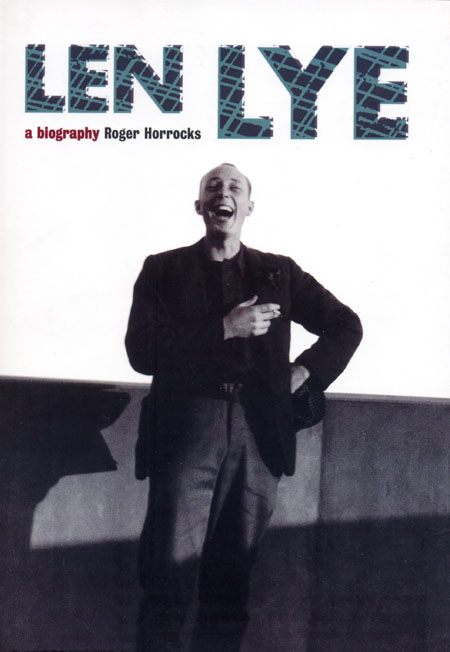
Kristin here–
David and I have many pleasant memories from our May visit to New Zealand, where as Hood Fellows we were resident at Auckland University for a month. Among these memories is meeting Roger and Shirley Horrocks. Roger has been a major figure in the development of film studies and culture in New Zealand. He founded the Department of Film, Television and Media Studies at Auckland University and was its head until his retirement in 2004. He co-founded the Auckland International Film Festival and has written on television and film in New Zealand.
Shirley is a producer and director of documentary films, many of them about Kiwi art and culture, made primarily for TVNZ and NZ On Air. In 1984 she founded her own production company, Point of View Films.
Retrieving Len Lye
Among the Horrocks’ accomplishments has been to aid in the preservation of the work of filmmaker/ sculptor/ painter/ poet/ theorist Len Lye (1901-1980) and to disseminate information about this undeservedly overlooked figure. Roger generously gave us a copy of his impressive book, Len Lye: A Biography, and Shirley presented us with a DVD of her documentary on Lye, Flip & Two Twisters, named for one of the artist’s sculptures.
I remember seeing a few Len Lye films long ago and thinking they were delightful and innovative. In working on our textbooks, I had the privilege of sitting in one of the British Film Institute’s refrigerated viewing rooms and seeing a gorgeous nitrate copy of his 1936 film Rainbow Dance. Color frames from it appear in Film Art (8th edition, p. 164) and Film History (2nd edition, p. 321). I had also seen Lye’s strange and evocative first film, Tusalava (1929), an animated film with abstract shapes much influenced by Maori and Australian Aboriginal art (illustrated on p. 176 of Film History).
Lye was born and grew up in New Zealand, lived for stretches in Samoa and Sydney, moved to London as a young man, and moved permanently to New York in 1944. He was extraordinarily attuned to sensory perception and rhythm and was drawn to the indigenous art of the southwest Pacific area. From an early age he studied modern art and especially abstraction.
Lye belonged to a generation of innovative animators who began working in the 1920s and 1930s: Oskar Fischinger in Germany and later the U.S., and Alexandre Alexeïeff and Claire Parker in France and later Canada. Although their styles differed considerably, all sought to find alternatives to Hollywood cel animation and to explore the relationship between music and cinema.
Roger and Shirley’s gifts inspired me to renew my acquaintance with Lye’s work and take a closer look at his career. “I’ll just order a DVD of Lye’s films,” I thought to myself. Back in the late 1980s Pioneer had issued a marvelous though brief series called “Visual Pioneers.” David and I had bought “The World of Oskar Fischinger” and “The World of Alexandre Alexeïeff.” I figured that these had probably been re-issued on DVD, along with the rest of this short-lived series. It turns out, no. Lucky we held onto those laserdiscs!
Unfortunately, there was never a “Visual Pioneers” disc devoted to Lye.
The age of DVDs has not served these filmmakers well, either. One has to be doggedly determined in finding and acquiring their work. The bountiful “Unseen Cinema” set from Image contains Oskar Fischinger’s An Optical Poem (1938), an abstract short film made for MGM (!) after the filmmaker moved from Germany to the U.S. It’s on the disc titled “Viva la Dance: The Beginnings of Ciné-Dance.” Although the set claims to deal with the American avant-garde up to 1941, Alexeïeff and Parker’s 1934 masterpiece Une nuit sur le Mont Chauve (Night on Bald Mountain) is included. I suppose the logic there is that Parker was an American, though she and Alexeïeff (born in Russia) made the film in Paris and worked thereafter in Europe and Canada. (A few other émigré directors’ European works are in the set, though I can’t see why Anémic cinéma by Marcel Duchamp [aka Rrose Sélavy] should be there.)
There is a French region 2 DVD of the pair’s work available. I found it for sale online at fnac and Cinedoc. A DVD of ten Fischinger films is available from the Center for Visual Music’s shop; it actually sells the disc through Amazon, which might make it relatively easy for some to acquire.
The Center’s shop carries a variety of experimental cinema, and there I found a collection of Lye’s films—on VHS. “Rhythms” contains twelve of Lye’s major works, including A Colour Box (1935) and Rainbow Dance. It was brought out by Re: Voir, a major distributor of avant-garde cinema. One can buy it from that company, though in the U.S. the Center is a convenient source. My copy from the latter came quite quickly.
The cassette does not include Tusalava. The only place that seems to be available is on YouTube, and I hesitate to recommend it, given the fuzziness of the image. (Poor copies of some other Lye films are there as well, but since the tape contains far better versions there is no good reason to link to them.) Tusalava survives in beautiful condition, and I hope it eventually could be added to an expanded Lye collection on DVD.
Don’t be misled by the collection “The Experimental Avant-garde Series Number 19–The Serious, the Silly, and the Absurd.” There the short Lambeth Walk Nazi Style is wrongly attributed to Lye–a fairly common mistake. Lye’s short, Swinging the Lambeth Walk (1939), is an abstract film using the same pop song as a soundtrack; it’s on the “Rhythms” tape.
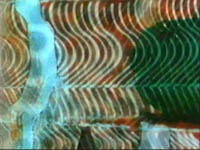
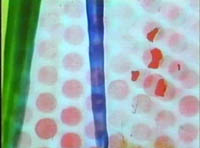
The Filmmaker
Perhaps one reason why Lye’s films command less attention today than they should is simply because they are so short. All twelve films on the “Rhythms” tape add up to a mere 47 minutes, and even the seven-minute Tusalava would fail to bring the total to one hour.
This paucity of footage results in part from the painstaking labor involved in making them. Some of Lye’s films depended on elaborate painting and scratching directly on 35mm film stock. This kind of animation was Lye’s innovation and not, as is widely assumed, that of Norman McLaren. A Colour Box looks remarkably like a McLaren film. The resemblance is not coincidental. One of the few periods during which Lye had institutional support was when he worked for the GPO Film Unit in London. McLaren was freshly out of art school and working at the same unit. He freely acknowledges his amazement at seeing and hearing A Colour Box and its influence on him: “Apart from the sheer exhilaration of the film, which intrigued me was that it was a kinetic abstraction of the spirit of the music, and that it was painted directly onto the film. On both these counts it was for me like a dream come true.” (pages 144-45 of Len Lye: A Biography.)
An equally revolutionary technique Lye used was no less time-consuming. The new color film stocks of the 1930s fascinated him, especially the three-strip processes. These recorded each of the three primary colors on a separate strip of black-and-white film, with the color of the final film being achieved by adding color dyes to the matrices and combining them. Technicolor is the most famous of these systems, though Lye drew upon European processes, including Gasparcolor. Lye seems to have been alone in his realization that one could use the three-strip technique on film shot originally in black-and-white.
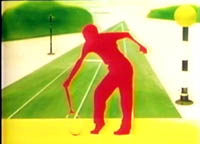
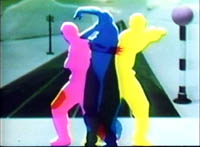
Rainbow Dance was made by shooting, in black-and-white, a human figure leaping, playing tennis, and executing other actions against a white screen and then using the result as a silhouette filled with vivid, saturated colors. Abstract and semi-abstract shapes surrounding the figure, constantly moving and changing, create a dazzling effect. The film ends abruptly with the message, “The Post Office Savings Bank puts a pot of gold at the end of the rainbow.” As advertisements, some of Lye’s films of the 1930s played in theaters, though viewers often perceived them as experimental shorts.
Another reason for the lack of attention paid to Lye is that he was always very much an eccentric loner, working on the periphery of Surrealism, Abstract Expressionism, and kinetic art. Works by him were included in exhibitions devoted to these trends, but Lye always refused the prominence that allegiance with fashionable movements might have given him. He was also highly impractical about money and not adept at explaining his projects to potential grant-bestowing foundations.
The Legacy
Roger Horrocks met Lye late in the artist’s life and worked as his assistant in his final months. Roger and Shirley were involved in setting up the Len Lye Foudation, housed at the Govett-Brewster Art Gallery in New Plymouth, New Zealand. (Its website is the best online source of information on Lye.) The foundation’s collection include extensive unpublished writings by Lye, to which Roger had complete access. He also interviewed a wide range of people who had known Lye in various capacities. The result is not only thorough, but it also gives a lively sense of a profoundly eccentric artist.
As part of Lye’s fascination with the senses, he deliberately cultivated a sort of stream-of-consciousness language, both for speech and writing. The result often suggests someone communicating in poetry rather than prose, and the quotations are not always easy to understand. One note scribbled after Lye had seen a film reads, “The knobbly cast of the star Elliott Gould, bemused, his mouth full of marbles, finally flapping his foot-flippers enrout insouciantly to some horizon or other” (p. 294). Roger, however, has waded through a large, difficult set of notes and journals. As he puts it, “It took my years to find my way round this chaotic collection of fragments and drafts, but ultimately it proved a goldmine.” One early reader of the biography remarked that “the book felt at times more like an autobiography than a biography” (p. 3). This is an astute observation, for Roger has woven many quotations into his own prose and thus given a structure to the chaos. By the end one feels that one understands not just the facts of Lye’s life but also his personality.
(Unfortunately the biography, published by Auckland University Press in 2001, is already out of print. With luck there’s a copy in your local library.)
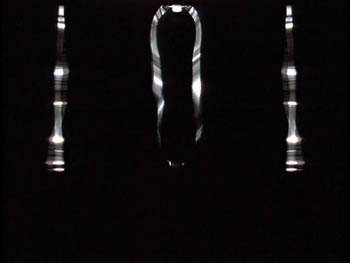
The Sculptor
For film fans and scholars with at least a passing knowledge of Lye’s shorts, the real news here will be his versatility as an artist. Before he started making films, he was already an accomplished painter. Because painting was a relatively inexpensive activity, Lye often did not promote his own work and simply gave the paintings to friends. He sought buyers and patrons for his kinetic sculpture, though, because he needed funding to build these ambitious projects.
A few museums, like the Museum of Modern Art and the Whitney, own Lye pieces, but on the whole his kinetic sculptures, many of which are large and difficult to maintain in working order, are not widely or continuously displayed. Indeed, much of Lye’s later life was devoted to designing huge pieces, only some of which have been realized even now. The Len Lye Foundation is committed to realizing posthumously the plans he left behind, though no doubt some of his more grandiose schemes will remain too impractical to render.
Shirley’s documentary Flip and Two Twisters (1995) helps fill in that side of the artist’s career for those who cannot travel to New Plymouth. Although she sketches Lye’s career and shows clips from some of the films, the real revelation is footage of Lye at work on some of the main pieces, like “Blade” (1954) and “Flip and Two Twisters” (1965). The dates, by the way, are a little misleading, as Lye continued to modify his sculptures after their initial versions were finished—usually making them larger.
“Flip and Two Twisters” is a casual name for a formidable piece, though Lye eventually took to calling it “Trilogy.” The sculpture consists of a large looped ribbon of flexible steel suspended from the ceiling, flanked by two vertical strips of similar steel. Once set in motion, the thrashing and twisting movements of these three elements gradually become quite loud and violent. Onlookers declare that it is frightening to be in the same room with the sculpture, as even just watching it on video makes plausible.
This documentary would be a terrific teaching supplement for a course on avant-garde cinema. Copies are available direct from Point of View Films.
Shirley gave us three of her other documentaries. Kiwiana (1996), as its name suggests, explores some of the icons of New Zealand’s popular culture. Kiwis were beginning to appreciate these neglected everyday objects, which were becoming collectibles in the 1990s: the buzzy-bee, the gumboot, and, yes, the kiwi fruit. Peter Jackson even makes a brief appearance as a talking head. Marti: The passionate eye (2004) chronicles the extraordinary life of Marti Friedlander, who was raised in a Jewish orphanage during the 1930s and 1940s in London. She was trained as a photography laboratory technician but also became a photographer. Emigrating to New Zealand, she worked on a series of Maori portraits and documented such moments of political ferment as the Women’s Movement. Finally, The New Oceania (2005) is a portrait of the Samoan-born writer Albert Wendt and his fostering of a new Pacific culture based on local traditions but embracing modernism. All of these films are available from Point of View.
We are grateful to Roger and Shirley for being among the many who made us feel so welcome in Auckland. I’m particularly grateful for being led to revisit and explore a director who deserves to be far better known.
A many-splendored thing 9: On, and over, the edge

Films from the Fragrant Harbor
Sorry to be late with this posting from the Hong Kong International Film Festival. The last three days have been mighty busy, including a morning of roundtables with journalists and local critics, a supper with Mr and Mrs Johnnie To, an encounter with Ringo Lam, and other escapades. Plus heavy viewings of classics by Li Han-hsiang. I hope to blog about all this before I leave on Thursday. In the meantime, I’ll catch up on what any good festival is about…the films. Or rather, the ones I’ve liked most in the last few days.
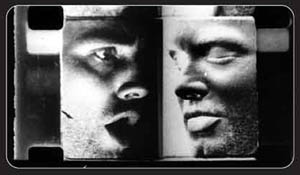
Paolo Gioli has been making experimental films since the 1960s. From one angle, his approach converges with the work of filmmakers like Ken Jacobs and Ernie Gehr. Gioli employs optical printing and other techniques to halt, fragment, and superimpose images, many of them from found footage. Perforations flutter across the screen and framelines dance; single-frame montage imparts hallucinatory movement to a static picture; negative and positive images bounce off one another. The very concept of a shot or of a film frame dissolves in this lovely work.
But Gioli’s originality goes beyond the tradition of recasting found footage. Anticipating recent gallery artists who rig up their own movie machines, he films with pinhole cameras made of buttons or seashells, or uses leaves to create an extra shutter. The results can be aggressive or lyrical, and I found them completely fascinating. The first of four programs of his work was my first sight of Gioli’s work. How could I have missed it?
All the five films in the set, mostly from the late 1960s and early 1970s, were very impressive. In Traces of traces (1969), the abstract whorls and speckles are made from filmstock pressed upon his skin and fingertips. According to My Glass Eye (1971) assaults us with a flurry of Muybridge-like postures and fluttering close-ups, all to a threatening drumbeat.
My favorite was the gentler Anonimatograph (1972), recomposed from a 35mm home movie from the 1910s and 1920s. The shots settle into layers, and as they peel off we see people in different phases of their lives, sometimes studying each other across the years. Family portraits become eerie silhouettes and cameos. Even gouges on the emulsion serve as testimony to time gone.
Mark McElhatten, an expert on experimental film, provided the catalogue essay and an enlightening introduction to the screening, as well as an after-film discussion. He pointed out Gioli’s fascination with the textures of the human body as they are shaped by time and space, and then captured on the skin of film itself. Film as a tactile medium: No surprise that Gioli is also a sculptor.
You can read more about his work in Mark’s detailed essay for a Lincoln Center retrospective. This is Gioli’s suitably sparse website, and here is a site offering a DVD collection (unhappily not including Anonimatograph).
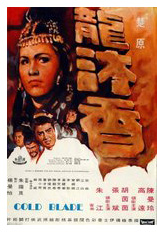 Cold Blade (1970) is a very different affair. This swordplay classic directed by the versatile Chor Yuen for Cathay has been fairly hard to see. (My first viewing came in 1997, at a Brussels retrospective.) The print screened by the HK Film Archive was restored from a Cathay negative, supplemented by sound from a copy held by Marie-Claire Quiquemelle of Paris. The result was a stunning print with vibrant color. The story of the restoration can be found here.
Cold Blade (1970) is a very different affair. This swordplay classic directed by the versatile Chor Yuen for Cathay has been fairly hard to see. (My first viewing came in 1997, at a Brussels retrospective.) The print screened by the HK Film Archive was restored from a Cathay negative, supplemented by sound from a copy held by Marie-Claire Quiquemelle of Paris. The result was a stunning print with vibrant color. The story of the restoration can be found here.
Cold Blade begins with a graceful title sequence showing our two heroes practicing their signature moves in slow motion and floating aerobatics. These maneuvers will of course prove important at the climax. The story was written for the screen, but it’s as full of twists and double-dealing as a martial-arts novel. The cutting is frantically fast (average shot length of 4.4 seconds!) but always intelligible. Chor Yuen provides his characteristically crammed fight scenes. His long lenses create layers of pulsing foreground movement that yield intermittent views of his protagonists. All in all, a satisfying reminder of the first golden era of Hong Kong action film.
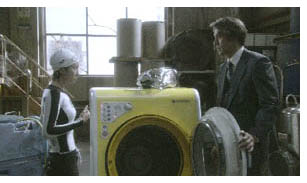 Then there was Baba Yasuo’s Bubble Fiction: Boom or Bust (2007), an international premiere that drew huge crowds and big laughs. Here’s one Asian film that won’t be remade in Hollywood; it’s already an unembarrassed riff on Back to the Future. Mayumi, a ditzy bar hostess, tries to prevent Japan’s financial collapse by returning to 1990 and blocking corrupt legislation. Her vehicle: a lemon-yellow Hyundai washing machine.
Then there was Baba Yasuo’s Bubble Fiction: Boom or Bust (2007), an international premiere that drew huge crowds and big laughs. Here’s one Asian film that won’t be remade in Hollywood; it’s already an unembarrassed riff on Back to the Future. Mayumi, a ditzy bar hostess, tries to prevent Japan’s financial collapse by returning to 1990 and blocking corrupt legislation. Her vehicle: a lemon-yellow Hyundai washing machine.
Naturally, Bubble Fiction is filled with retro music, dances, fashions, and hair styles, with plenty of in-jokes about J-pop culture and references to its Hollywood source. “Don’t tell me you came in a DeLorean?” a skeptic asks our heroine. Bubble-era Japan is tellingly satirized, with profligate salarymen in loose suits lined up and waving banknotes to flag down cabs. The director painstakingly reconstructed the Tokyo of the time, including elaborate desserts and hand-punched train tickets.
Of course catastrophe is thwarted, and Mayumi comes back to a sunnier future, having gained a father and a new place in the community. Lighter than air, full of ingratiating gags, and cleverly crafted on Hollywood’s script model, Bubble Fiction proved just the sort of good-natured movie that I needed after 3 ¼ films earlier that day. Fragrant Harbor filmmaker Tsui Hark once wisely remarked: “Sometimes it’s fun to be stupid.”
For credits and further info, check out the Pony Canyon site and Russell Edwards’ Variety review.
In the wake of Infernal Affairs, Hong Kong movies have been filled with undercover cops turning confused, bitter, and suicidal. On the Edge (2006) from the Herman Yau retrospective here at the festival, is one of the very best. Like Yau’s From the Queen to the Chief Executive, this starts from a social fact: Most moles returning to duty don’t last more than a few years. Why? On the Edge explores the possibility that the friendships forged in the underworld are more authentic and durable than the stern bureaucracy of law and order.
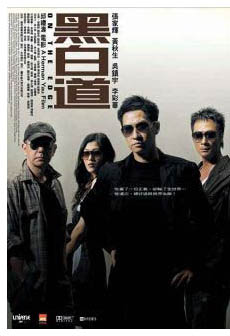 The film begins with mole Nick Cheung betraying his father-figure Francis Ng. When he tries to readjust to life in the force, other cops keep away, Internal Affairs bureaucrats trail him, and he’s kept out of the loop. His new partner Anthony Wong goads him and flagrantly pounds up suspects, as if to prod Nick into defending the lowlife he once moved among. He sinks into alcoholism and tries to win back his girlfriend. A finely judged scene shows him revisiting a nightclub at which he’d once won the Triads’ trust. He shifts awkwardly between the bravado of a gang member and the panic of an outgunned policeman.
The film begins with mole Nick Cheung betraying his father-figure Francis Ng. When he tries to readjust to life in the force, other cops keep away, Internal Affairs bureaucrats trail him, and he’s kept out of the loop. His new partner Anthony Wong goads him and flagrantly pounds up suspects, as if to prod Nick into defending the lowlife he once moved among. He sinks into alcoholism and tries to win back his girlfriend. A finely judged scene shows him revisiting a nightclub at which he’d once won the Triads’ trust. He shifts awkwardly between the bravado of a gang member and the panic of an outgunned policeman.
Thanks to a flashback structure, we see Nick’s rise in the gang juxtaposed to his slump once he’s back in uniform. Without being heavy-handed, the film juxtaposes a scene of Nick trying to return to civilian life with a parallel moment in his Triad days. It isn’t easy to advance two stories at once, but Yau manages it easily. There are also many sharp character bits, expressed—as customary in Hong Kong films—through confrontations and combats. A scene in nightclub builds tension as Ng and Wong, crook and cop, seize karaoke microphones to bark challenges to one another.
Without recourse to the flourishes of a certain Hollywood film on a similar theme, On the Edge exposes the anguish of a man cut adrift from the world that gave him his identity. Simple and modest, but with subtle touches (watch out for the disabled man on the handcart), Yau’s B-film aesthetic deals straightforwardly with plot, character, pungent locations, and a fine cast. You don’t need portentous symbols like a rat skittering along a condo railing. Just tell the story of one man who lost himself.
3 notions about CREMASTER 2
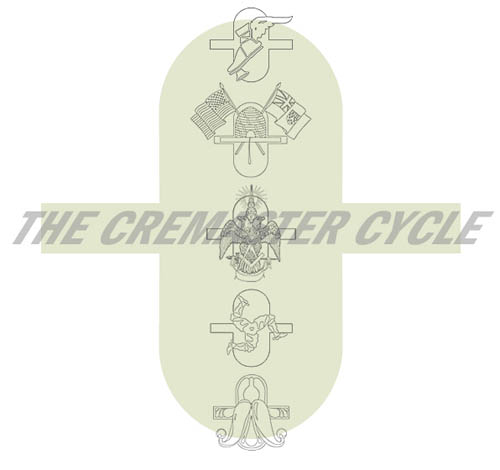
DB here:
The week before last brought Matthew Ryle to the UW–Madison campus for a talk and a panel discussion. As Ryle pointed out, it’s hard to decide exactly what he should be called. He has the title of Chief Fabricator at Matthew Barney’s studio, and in Barney’s Cremaster film cycle he serves as Production Designer. He’s been called a Set Designer too, and he assists in the making of sculpture pieces that Barney exhibits in museums. Ryle is an important artifact-maker in his own right, having built the tallest sign in North America.
 Nobody could have been more unpretentious than Matt Ryle, in olive sweatshirt and blue jeans, explaining the whys and wherefores of Barney’s enigmatic art. He gave a concise introduction to Cremaster 2, pointing up its reliance on Mailer’s nonfiction novel about Gary Gilmore, The Executioner’s Song. After the film, Ryle talked about the film’s Mormon and Masonic symbolism and the connections that Barney finds among killer Gilmore, Houdini, and the 1893 International Exposition, which Barney relocates from Chicago to Alberta, Canada.
Nobody could have been more unpretentious than Matt Ryle, in olive sweatshirt and blue jeans, explaining the whys and wherefores of Barney’s enigmatic art. He gave a concise introduction to Cremaster 2, pointing up its reliance on Mailer’s nonfiction novel about Gary Gilmore, The Executioner’s Song. After the film, Ryle talked about the film’s Mormon and Masonic symbolism and the connections that Barney finds among killer Gilmore, Houdini, and the 1893 International Exposition, which Barney relocates from Chicago to Alberta, Canada.
Ryle discussed some of Barney’s filming procedures too. Barney shoots plenty of coverage, with many angles to permit inserts and matches on action. He favors delicate and lustrous lighting, both in the exteriors and the interiors, many of which are studio sets. Cremaster 2 cost about $1.7 million, and it looks it. There is ambitious CGI work in the Mormon Tabernacle, and the imagery is often spectacularly beautiful, showing off the landscapes of the Bonneville Salt Flats and Canadian glaciers and enticing props like the glittering mirrored saddle and the shapely furniture that surrounds the players.
The films
For those who haven’t yet heard, Cremaster is a series of five films made between 1994 and 2002. Each one suggests a narrative, but it doesn’t give us a traditional plot. Rich in surreal details, the action presents humans and fantastic creatures, most in fairly static postures or caught in repetitive actions. They exist in vacant spaces, either colossal ones, like a blimp or the Utah landscape, or cramped chambers. Their actions and circumstances work out Barney’s private mythology, which is based on the descent of the testes during the embryo’s development in the womb. (The cremaster is the muscle that controls the contractions of the testes.) As in the paintings of Salvador Dalí (another artist interested in bodily penetration and drippy fluids), the actions we see symbolize public and historical events, but at one remove and filtered through esoteric symbolism.
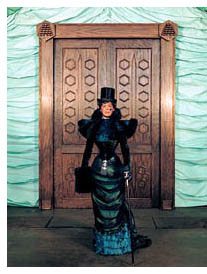 Cremaster 2, which we saw last week, is one of the most accessible installments, but it’s still very opaque. It begins with imagery of stupendous horizons, some tipped vertically. We’re introduced to several figures who’ll recur: an astonishingly wasp-waisted woman, a young man and woman who seem to be consulting her for advice, Harry Houdini being trussed up for an escape, and a desperate man parked at a gas station. There are also some isolated actions, most memorably a man and woman in coitus, with her pinched waist encased in a plastic girdle. There are bees, honey, saddles, cowpokes, and petroleum jelly. The film interweaves these materials around certain emblematic actions. Crucially, the young man in his Mustang (which is coupled by fabric to another Mustang) shoots the station attendant and eventually is executed by means of a rodeo bull-ride.
Cremaster 2, which we saw last week, is one of the most accessible installments, but it’s still very opaque. It begins with imagery of stupendous horizons, some tipped vertically. We’re introduced to several figures who’ll recur: an astonishingly wasp-waisted woman, a young man and woman who seem to be consulting her for advice, Harry Houdini being trussed up for an escape, and a desperate man parked at a gas station. There are also some isolated actions, most memorably a man and woman in coitus, with her pinched waist encased in a plastic girdle. There are bees, honey, saddles, cowpokes, and petroleum jelly. The film interweaves these materials around certain emblematic actions. Crucially, the young man in his Mustang (which is coupled by fabric to another Mustang) shoots the station attendant and eventually is executed by means of a rodeo bull-ride.
I saw the Cremaster cycle at the end of summer 2003, when it ran at one of Madison’s art cinemas, the Orpheum. It was a pretty strange venue for this work, since in its heyday the old picture palace once ran Fred and Ginger movies. The Sunday I went, the entire cycle was screened in numerical order. I thought that some installments were very engaging, especially no. 5, a sort of operatic music video set in Budapest. Most of the others offered quite arresting imagery but seemed to me protracted and overbearing in their symbolism. By the end of the day my own cremaster was protesting.
Watching Cremaster 2 last Thursday, I was again absorbed by its imagery and, alas, still resisting the clanking machinery through which every figure, gesture, setting, and surreal juxtaposition called out for some Meaning, however elusive. In a tradition that runs back at least to Ulysses, Barney cooks up an interpretive feast for critics. The monstrous book treating the films and the kindred photographs and objects is, like the movies, at once luxuriant and fearsome. It starts with a ninety-page essay by Nancy Spector that explicates the films’ symbolic dimensions. Here’s a sample, from a discussion of Cremaster 4:
machinery through which every figure, gesture, setting, and surreal juxtaposition called out for some Meaning, however elusive. In a tradition that runs back at least to Ulysses, Barney cooks up an interpretive feast for critics. The monstrous book treating the films and the kindred photographs and objects is, like the movies, at once luxuriant and fearsome. It starts with a ninety-page essay by Nancy Spector that explicates the films’ symbolic dimensions. Here’s a sample, from a discussion of Cremaster 4:
The Loughton Ram, with wool dyed red and all four horns decked in ribbons of yellow and blue Manx tartan, stands at this junction—a symbol for the total integration of opposites, the urge for unity that fuels this triple race. But before the three entities—Candidate, Ascending Hack, and Descending Hack—converge, the screen goes white and silent. This blankness bespeaks the annulment of desire. (63)
Just what I’d feared: every little movement has a meaning all its own. In addition, the essay’s prose style is forbidding in its rodomontade.
With his simple diagram of the field emblem Barney libidinizes architectural space and the surrounding environs, which come to represent the externalization or materialization of inner drives (8).
Surrounding environs, as opposed to non-surrounding ones? Inner drives? What would outer drives be? As for the sentence’s meaning, couldn’t one simply say that “The emblem makes erotic drives manifest”?
Three Thoughts
Anyhow, I just wanted to use today’s blog to externalize, or materialize, or maybe even libidinize, three hypotheses about Cremaster 2.
1. It is Big Art, All-Enveloping Art. It wants to meld many systems of meaning: religion (Mormonism, Judaism), science (fetal development, geological change), history (the Columbian exposition, Gilmore’s killing spree), literature (Mailer’s novel), and more. In this it belongs to a tradition of omnivorous artworks, from Ulysses and Finnegans Wake down to Pynchon, Syberberg, and Greenaway. The artist as demiurge, creating a master-scheme whose correspondences radiate out to many cultural systems: Eisenstein may have been the first filmmaker (in his unmade Moscow project) to attempt something on this scale, but he wasn’t the last.
At the same time, Postmodernist art characteristically absorbs these vast systems in an oblique way, through roundabout citation. I think of Robert Wilson’s Theatre of Images and his collaboration with Philip Glass on Einstein on the Beach. In a rarefied arena, obscure or trivial actions are played out, mysteriously referring to historical events or other artworks. If you don’t know the role of trains or violins in Einstein’s life and thought, you’re arrested by the pure juxtaposition. If you catch the cites, or more likely do your outside reading, you’ll discover an associative logic binding the tableau together. The same strategy of obscure allusion is on view in Glass’s theatre piece about Muybridge, The Photographer.
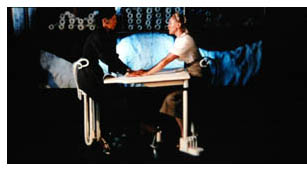 Something similar happens with Cremaster. As Matt Riley pointed out, Barney’s tableaus can tease you into doing research to find connections, however tenuous, among Gary Gilmore and Harry Houdini, or the Mormons and a Sinclair gas station. But to his grand synthesis, Barney has added autobiography. As in the work of Dalí, Cocteau, and Joseph Beuys, veiled references to public history are mixed with wisps from the artist’s life—in this case, an athletic career and modeling in New York. Beuys’ animal fat (recalling his purported plane crash during World War II) finds its equivalent in Barney’s petroleum jelly, used to keep his shoulder pads flexible during a football game.
Something similar happens with Cremaster. As Matt Riley pointed out, Barney’s tableaus can tease you into doing research to find connections, however tenuous, among Gary Gilmore and Harry Houdini, or the Mormons and a Sinclair gas station. But to his grand synthesis, Barney has added autobiography. As in the work of Dalí, Cocteau, and Joseph Beuys, veiled references to public history are mixed with wisps from the artist’s life—in this case, an athletic career and modeling in New York. Beuys’ animal fat (recalling his purported plane crash during World War II) finds its equivalent in Barney’s petroleum jelly, used to keep his shoulder pads flexible during a football game.
These films assign you homework. Fortunately we have cheat sheets. Like Joyce and Greenaway, Barney has explicated his work’s public and private mythology. The bare bones are laid out on the cycle’s official website. Since free-associative interpretation is the modus operandi of most academic criticism, highly associative art like this has the effect of playing to commentators’ strengths. The Cremaster book includes not only Spector’s blow-by-blow explication but also an imposing glossary, with entries running from anus-island to zombie, illuminated by snippets from fiction and literary theory. Barney will keep critics very busy for a long time: Some Cremaster scenes are as iconographically dense as a mannerist Annunciation.
2. Stylistically the films go down like milkshakes. There may be less here than meets the eye, but what meets the eye is pretty gorgeous. The installments have the smooth cutting and meticulous compositions of Cocteau’s Orphée. Their limpid camera movements, swooping helicopter shots, and luscious color design could pass muster in a Hollywood production. The films flaunt their production values, and you could argue that this can make them attractive to young people who might find rougher-edged or lower-budget experiments by Ernie Gehr or Lewis Klahr harder to take. Though the shots run moderately long (averaging 9-10 seconds in the films I clocked), the insistence on close-ups, arcing camera, and slow zooms recalls that cluster of current Hollywood techniques I’ve called “intensified continuity,” and this helps contemporary audiences concentrate on the tableaus.
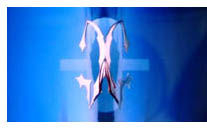 Another user-friendly aspect, touched on in the panel discussion: The echoes of the horror film. We’re on edge from the start of Cremaster 2, with Jonathan Bepler’s rumbling score rising dissonantly as the bleeding logo hurtles out at us, looking like a thorny torture device. The dripping nose and bolted mouth of Baby Fay la Foe, the bees swarming over the thrash-rock musician as he makes a call, and the bloody body of the gas station attendant offer us some fairly pure horror-movie iconography. It could just as easily be called Creepmaster.
Another user-friendly aspect, touched on in the panel discussion: The echoes of the horror film. We’re on edge from the start of Cremaster 2, with Jonathan Bepler’s rumbling score rising dissonantly as the bleeding logo hurtles out at us, looking like a thorny torture device. The dripping nose and bolted mouth of Baby Fay la Foe, the bees swarming over the thrash-rock musician as he makes a call, and the bloody body of the gas station attendant offer us some fairly pure horror-movie iconography. It could just as easily be called Creepmaster.
3. Might not this be the Artworld’s parallel to a Hollywood blockbuster franchise? The Cremaster films are designed chronologically, like sequels are. They have spawned fan videos and fan music. They spin off ancillaries, such as the souvenir volume I’ve already mentioned, along with T-shirts, baseball caps, and coffee mugs. Since this is the Artworld, though, the real ancillaries are the photographs, drawings, and sculptures that tour on exhibit. In early 2004 one photo triptych from Cremaster 2 fetched over $186,000. The film has become a precious object in itself. Only ten institutions, we’re told, can acquire prints, and the series won’t be released on DVD.
Those who think that many contemporary museum shows are really about the shop will find strong evidence here. In today’s art market, Cremaster might be the gallery scene’s equivalent of the summer megapicture, the project that by virtue of its monumental scale and production values generates income at many levels indefinitely. Again, the showmanship of that adroit impresario Dalí comes to mind.
From this perspective, Barney becomes the equivalent of an A-list movie producer or director, overseeing a platoon of artisans like Matt Ryle who bring his vision to life. Cremaster reminds us of the ambiguities in the word studio, applied both to moviemaking and the fine arts. For hundreds of years successful painters have in their studios divided the labor of artmaking, planning the overall design and assigning juniors to fill in bits before the supervisor added his distinctive touch. Warhol revived this in ironic mode with his Factory, often by denying he had a touch by leaving all the work to others. But Warhol’s films struck observers as crude and offhand, while Barney has produced something bold, polished, and overwhelming. If Warhol was the Roger Corman of the Artworld, Matthew Barney may be its Jerry Bruckheimer.
PS: In correspondence Professor Jim Kreul has called my attention to an article that anticipates my third point: Alexandra Keller and Frazer Ward, “Matthew Barney and the Paradox of the Neo-Avant-Garde Blockbuster,” Cinema Journal 45, 2 (2006), 3-16. It considers in detail the relationship of Barney to performance art as well.
Lewis Klahr X 3, X 4
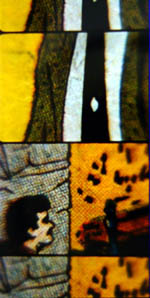
DB here:
Last Saturday Lewis Klahr came to Madison, brought by the Starlight Cinema group of the University’s Student Union. He showed two sets of films: The Two Minutes to Zero Trilogy (2003-2004) and Daylight Moon (A Quartet) (2002-2004). He’s one of the most gifted collage animators in the American avant-garde, surely the most accomplished since Larry Jordan. Both filmmakers work in the Surrealist tradition, but Jordan seems more drawn to images from nineteenth-century illustration, while Klahr loves US pop culture. As a baby boomer who came of age in the 1970s, he recycles magazine ads, comic books, and book illustrations in lyrical and sometimes aggressive ways.
Tipped off by Tom Gunning, I first encountered Klahr’s work in The Pharoah’s Belt (1993), his most famous film. I also enjoyed seeing his film-within-a-film in Miguel Almereyda’s imaginative Hamlet (2000). At a recent Hong Kong International Film Festival I saw The Two Minutes to Zero Trilogy and decided to study it a bit. I contacted Klahr and he kindly sent me the film, along with Daylight Moon, and some lovely work by Janie Geiser, an accomplished filmmaker in her own right. You can get examples of their work on this DVD from Craig Baldwin (himself an extraordinary filmmaker).
Seeing the Trilogy again, I was even more impressed by it. Each of its three parts consists of images snipped out of old 77 Sunset Strip comic books, with each part implying a bank holdup and a chase, but each time the events are compressed more and more. The last episode runs only one minute. “A feature length narrative compressed 3 different times into 3 separate films of diminishing duration until the synoptic is synopsized,” as Klahr puts it.
Don’t try to find a plot. Each episode uses just enough cops-and-crooks iconography to tease us into trying to create a coherent narrative, but it frustrates that in several ways. The images refuse to settle down, slipping and snicking past your eye in an imitation of saccadic glances. The microscopically short snippets recall multitrack sampling. In the Madison Q and A, Klahr called it a “pan and scan aesthetic.”
Sometimes the cartoon panels jerking past the camera create a weird effect of motion. A man dodging into a car with a valise seems to be whizzing off, a woman seems–for only one frame–to wave a sheaf of bills.
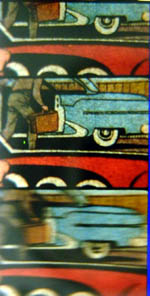
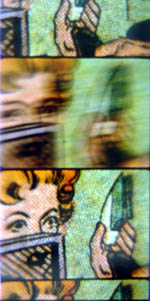
The cutting is rapid-fire as well. I’d thought that Klahr had edited in the camera, but he spliced everything. A certain maniacal precision becomes evident when you can actually look at the images on the strip and see the bold shot-changes, like the one crowning this post. The trilogy evokes the rush of a heist film without ever giving us more than glimpses of what the narrative might be. The sense of action hurtling toward chaos is cranked up by soundtracks using roaring guitar music from Rhys Chatham and Glenn Branca.
Daylight Moon (A Quartet) was far more relaxed. I saw it as a meditation on childhood and its sensitivities, fears, and moments of awe and mystery. (A touch of Joseph Cornell, maybe.) Valise is dominated by the vastness of our planet and the cosmos; Hard Green gives us comic-book imagery of military combat. Soft Ticket was a lyrical remembrance of baseball cards, and the finale, Daylight Moon blended imagery of kid culture and suburban utopias with the soundtrack of Night of the Hunter.
Klahr talked about the quartet as “the best film I’m ever likely to make,” largely because it achieved his aim of a “democracy of subjectivity.” He meant by this the poetic power of the juxtapositions he creates, which invite viewers to connect the material in unpredictable ways. Hollywood films, he remarked, try to get us all to experience the material in a single way, and that’s suitable for a mass audience. But collage films like his have a “signal to noise ratio” that allows viewers to tune in to something, drop out for a few moments, and then tune in again.
For each viewer, the high-information moments will be different, and if a viewer returns to the film, he or she will probably find new images to focus on. This time through the Quartet, I noticed that each of the first three films had a recurring male figure–a sea diver/ astronaut, a soldier, baseball players–until Daylight Moon ends with a man stretched out on a used car. This would seem to be a reverie about a boy’s childhood.
Klahr is a warm, unpretentious speaker and he engaged the audience in a lively dialogue. His work deserves to be more widely known. I can’t imagine watching the Trilogy on DVD; could digital sampling capture the REM effects of the blurring pans? Still, a release on that format would surely expand his circle of admirers.













